By the Numbers

China’s Soybean Imports Surged in May on Buying From Brazil
Bloomberg | June 07, 2020 | International Trade | Commodity | By The Numbers
Soybean imports by China rose 27% in May from a year earlier, after crushers increased purchases from Brazil to take advantage of cheap supplies amid strong crush margins.
China’s Copper Imports Drop as Overseas Lockdowns Tighten Supply
Bloomberg | June 07, 2020 | International Trade | Commodity | By The Numbers
China, the world’s largest copper consumer, imported less metal and concentrate last month as pandemic-driven lockdowns in overseas mining regions disrupted supplies.
Oil rises again on renewed OPEC+ meeting hopes - Rystad
AJOT | June 05, 2020 | Energy | Conventional | By The Numbers
Rystad Energy’s daily market comment from our Head of Oil Markets Bjornar Tonhaugen: It’s all about the OPEC+ meeting. As it was initially intended to happen on Thursday, when that did not materialize, prices fell because traders sensed a lack of agreement between the extended group’s producing countries. Now the mood has changed again and prices rose, following news that a consensus may have been reached and a meeting is across the corner. It now seems very likely that OPEC+ will meet tomorrow to hash out a deal to extend the current May-June deep cuts for one more month. Rumors have it that a breakthrough was reached with Iraq last night and crude prices resumed gains this morning, both for Brent and WTI. Iraq has struggled to comply fully with their 1.061 million bpd target cut, delivering only around a 400,000 bpd cut for the first month of May 2020. Assurances and agreements with IOCs operating in Iraq has now been reached, and Iraq has a higher chance of being able to reduce production from the giant IOC-operated fields in the Basrah region than ever before. However, we are still skeptical that Iraq will be able to deliver the 1 million bpd cuts in full, and for now see an additional cut of 100,000-200,000 bpd in July as more likely. The more interesting question for the oil market right now is what happens from August onwards. As long as the demand recover stays intact, we believe the crude market will be in deficit also in August and onwards, despite cuts being tapered by 2 million bpd to the scheduled 7.7 million bpd level. That will ensure a fundamental support for prices, while also spurring a quicker reactivation of curtailed US oil production, and eventually frac crews ending their holidays early. Indications show that a bit more than 300,000 bpd from shut US production is actually coming back online already from June as a result of the current price levels. OPEC+ is fully aware of this balancing act as they prepare to meet virtually over the weekend. And the producers are not just interested only at reactivating production, they have a stock build that they want to trim as well. The deficit will help reduce that burden and bring back healthier price levels sooner than it was maybe thought. So, even if demand exceeds supply for a while, that does not mean that we really have a problem to source oil. Oil is there, lots of it, waiting to be drawn from storage facilities.
The Global Forest Industry First Quarter 2020
AJOT | June 05, 2020 | International Trade | Commodity | By The Numbers
There were relatively few price changes for sawlogs throughout the world in the 1Q/20 despite interruptions in trade and uncertainty in short-term lumber demand in many of the key markets.
FTR Reports North American Class 8 Net Orders Remain Subdued in May at 6,600 Units
AJOT | June 03, 2020 | Intermodal | Trucking | By The Numbers
FTR reports preliminary North American Class 8 net orders for May remained subdued at 6,600 units. While up 61% from the dismal April activity, the May orders were down 37% y/y. Class 8 net orders for the last twelve months total 155,000 units.
FIS Air Freight Report June 2, 2020
AJOT | June 02, 2020 | By The Numbers
The China to USA route begins a very sharp slide into weaker territory, down -22.44% in one week to a still relatively high level of $7.12. China to Europe, supported by price strength out of Hong Kong, drops out a shallower 6.97% or 55 cents.
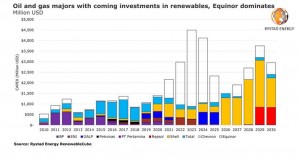
Among oil majors promising renewable investments, only one is putting serious money on the table
AJOT | May 29, 2020 | Energy | Conventional | By The Numbers
Investments in solar and wind energy projects by the world’s oil majors over the next five years are expected to reach $17.5 billion, a Rystad Energy analysis finds.
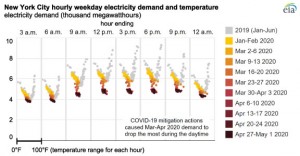
Daytime electricity demand in New York City most affected by COVID-19 mitigation actions
AJOT | May 22, 2020 | Energy | Conventional | By The Numbers
Actions to mitigate the 2019 novel coronavirus disease (COVID-19) have caused daily weekday electricity demand in New York City to decrease by 16% in April compared with expected demand, after accounting for seasonal temperature changes.
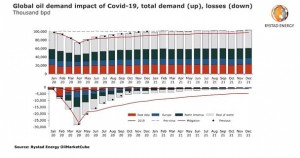
Road fuels get a small boost, US oil demand revised higher, Europe’s lower
AJOT | May 22, 2020 | Energy | Conventional | By The Numbers
Rystad Energy’s weekly comprehensive Covid-19 report calculates the effect of the novel coronavirus on our lives and offers updated estimates for global fuel markets.
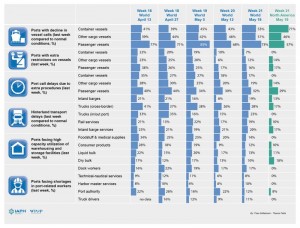
Global Survey on impact of COVID19 on ports: regional differences becoming more pronounced
AJOT | May 22, 2020 | Ports & Terminals | Ports | By The Numbers
IAPH-WPSP Port Economic Impact Barometer for week 21 also confirms global trend towards decreasing capacity utilization of liquid and dry bulk storage at ports
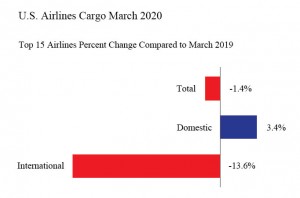
March 2020 U.S. Airline Cargo Data (Preliminary): International Cargo Weight Down 14%
AJOT | May 21, 2020 | Air Cargo | Freighters | By The Numbers
U.S. airlines carried 1.4% less cargo by weight in March 2020 than in March 2019, according to preliminary data filed with the Bureau of Transportation Statistics (BTS) by 15 of the leading cargo airlines.
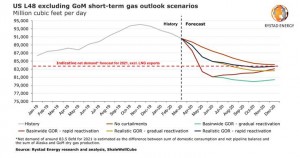
US gas production set to hit bottom in November due to Covid-19-related shut-ins and drilling decline
AJOT | May 19, 2020 | Energy | Conventional | By The Numbers
The Covid-19 pandemic has forced oil and gas producers to slash budgets and reduce drilling activity, which in the US always affects future hydrocarbon output as existing fields naturally decline.
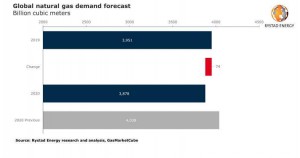
Global demand for natural gas will drop 2% in 2020 as Covid-19 lockdowns take toll
AJOT | May 18, 2020 | Energy | Conventional | By The Numbers
Commercial and industrial demand for natural gas is declining as most countries around the world impose lockdowns to limit the spread of the Covid-19 pandemic. Rystad Energy estimates global natural gas demand to fall by almost 2% this year as a result of the lower activity.
Rystad: Oil seen down 10.9%, jet fuel down 33.6%, road fuel down 11.1% in 2020
AJOT | May 15, 2020 | Energy | Conventional | By The Numbers
Rystad Energy’s weekly comprehensive Covid-19 report calculates the effect of the novel coronavirus on our lives and offers updated estimates for global fuel markets.
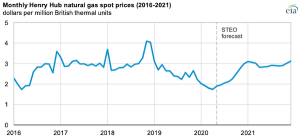
EIA expects lower natural gas production in 2020
AJOT | May 15, 2020 | Energy | Conventional | By The Numbers
EIA expects U.S. marketed natural gas production to average 94.3 billion cubic feet per day (Bcf/d) in 2020, down from 99.2 Bcf/d in 2019.
FTR Reports April Preliminary Net Trailer Orders Sink to Lowest Level in Modern Era at 300 Units
AJOT | May 15, 2020 | Intermodal | Trucking | By The Numbers
FTR reports preliminary net trailer orders for April sunk to the lowest level in the modern era (since 1990) coming in at just 300 units. April order activity was -95% m/m and -98% y/y. Trailer orders for the past twelve months now total 162,000 units.
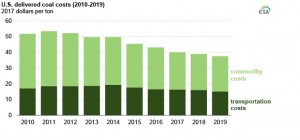
Coal transportation rates in the United States decreased for the fifth consecutive year
AJOT | May 12, 2020 | Energy | Conventional | By The Numbers
U.S. delivered coal costs, which reflect commodity and transportation costs, have declined steadily since 2010 (in constant 2017 dollars per ton). In 2019, the average transportation cost of coal was $15.03 per ton, down from $16.07 per ton in 2018. Transportation costs accounted for about 40% of the total delivered cost of coal in 2019, down 1% compared with the previous year. In the past 10 years, coal commodity costs have fallen faster than transportation costs. As a result, transportation's share of the total delivered cost of coal has increased since 2008, when transportation accounted for about one-third of the total cost.
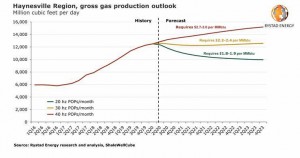
US’ top gas basin for LNG exports set for 20% output decline in a $1.80-$1.90 Henry Hub scenario
AJOT | May 12, 2020 | Energy | By The Numbers
The Haynesville gas basin, arguably the most important basin for liquefied natural gas (LNG) exports in the US due to its proximity to existing and planned terminals, is set for a 20% decline in output towards 2023 if Henry Hub prices average at $1.80-$1.90 per million British thermal unit (MMBtu), a Rystad Energy analysis reveals.
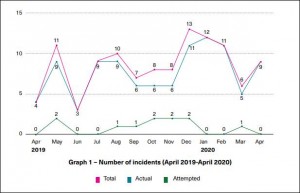
Situation of Piracy and Sea Robbery in Asia for April 2020
AJOT | May 11, 2020 | Maritime | By The Numbers
ReCAAP Information Sharing Centre today issued its April 2020 Report on the situation of piracy and armed robbery against ships in Asia. A summary is appended.
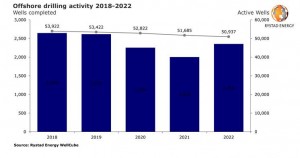
Remote work technology: The one oil and gas services segment that Covid-19 has benefited
AJOT | May 08, 2020 | Energy | Conventional | By The Numbers
There are no hard numbers yet to illustrate the extent to which the Covid-19 pandemic has affected the oil and gas industry’s digitization. However, a Rystad Energy analysis of service companies’ earnings calls reveals a clear growth in cost-saving remote work technologies.
© Copyright 1999–2024 American Journal of Transportation. All Rights Reserved
